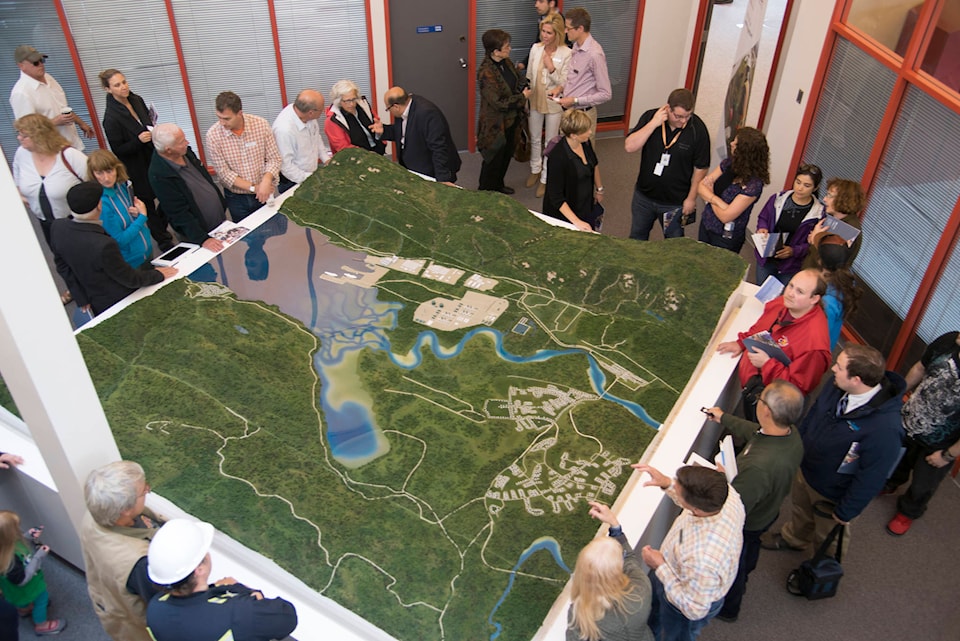Already hailed by politicians and industry analysts as “the largest single private sector investment in Canadian history,” LNG Canada’s $40 billion stated cost is going to exceed that figure once fully built out.
That’s because the price tag so far includes just two of the massive four steel production units planned for the 250 hectare-plus plant location at Kitimat which will super-cool natural gas into liquid form for transfer to waiting tankers for the journey across the Pacific to Asian customers.
There’s no decision yet to add the third and fourth cooling units, called “trains” in the liquefied natural gas business, but LNG Canada officials describe their costs as “incremental” given the infrastructure work already underway for the first two trains.
Together, those first two trains will have the capability of producing 14 million tonnes of LNG a year. By comparison, a LNG plant in Lousiana built by Cheniere Energy Partners LP, which was completed in 2016 and which has been adding capacity ever since, is scheduled to produce 22.5 million tonnes a year when a fifth train is finished next year.
READ MORE: LNG Canada project gets green light
To date the largest LNG Canada project cost component is the overall engineering, procurement and construction contract which has gone to two companies, American-based Fluor and JGC from Japan, working as joint venture partners.
That contract value is placed at just under $18.5 billion, divided into just over $11 billion for Fluor and just under $7.5 billion for JGC.
“Approximately 60 per cent of the total budget for the overall project will be spent in British Columbia. The remainder will be spent in other parts of Canada, and overseas for construction of the modules,” says senior LNG Canada official Susannah Pierce.
$6.2-billion Coastal GasLink pipeline
Helping flesh out the overall $40 billion cost is TransCanada’s Coastal GasLink 670 kilometre-long pipeline which will carry natural gas from northeastern B.C. to Kitimat.
That pipeline’s cost is $6.2 billion, of which $620 million has been awarded to various First Nations-affiliated companies along the route.
By itself, Coastal GasLink is arguably the second largest private sector project in Canadian history, topping Rio Tinto’s Kitimat aluminum smelter rebuild pegged at $6 billion.
Other costs connected to LNG Canada itself include site preparation, dredging around and rebuilding of an existing wharf where the LNG-carrying tankers will dock, diversion of creeks at the plant location, other environmental mitigation and the years-long expenditures of steering the project through to obtaining environmental approvals.
That existing wharf had been owned by Rio Tinto, but a $567 million deal has now placed it under the control of LNG Canada.
Over and above the site construction and associated works and the pipeline are costs being borne by LNG Canada’s prime investors — Shell, Malaysian-state owned Petronas, PetroChina, Mitsubishi from Japan and Korean-owned KOGAS.
Their expenditures include collecting the northeastern natural gas and ultimately the tankers for transporting the final super-cooled fuel overseas.
Those costs are broken out within the overall $40 billion project total with Pierce citing the information as “commercially senstive.”
Also unknown, and a factor which could help push the project over and above that $40 billion figure, is the prospect of LNG Canada having to pay import tariffs on the fabricated industrial steel components making up the modules included in the trains.
Those tariffs were placed by the federal government in response to lobbying by eastern steel manufacturers who argued that steel, from mostly Asian countries, was being dumped on the Canadian market at below cost, thus creating an uneven playing field for domestic producers.
Prior to LNG Canada being given the official go ahead in early October, the company had been strenuously arguing for relief from the tariffs, saying the size of the modules was beyond the production capacity of domestic producers who had even suggested they could create a lower mainland B.C. base for their production.
The modules, at 50 metres high or the equivalent of a residential building 17 storeys tall, would be constructed overseas and then assembled on site.
LNG Canada also hinted the potential added cost, placed at $1 billion by some analysts, could affect a final investment decision.
The matter is now before a Canadian court and with the project now going ahead regardless, LNG Canada’s Pierce says the company is hopeful of a decision in its favour.
“LNG Canada remains confident in our position that large, complex LNG modules cannot be constructed in Canada, and therefore would not harm the domestic industry. As such, they should not be [tariff] subject goods,” she says.
“The total project cost assumes we have been successful in the argument we made to government in our application with respect to the application of anti-dumping and countervailing duties on large complex modules required by LNG Canada.”
The company also says there is plenty of steel required for other portions of the project that could come from domestic producers.
As an example, it says civil and earth works and associated needs require 13,000 metric tonnes of rebar alone.
